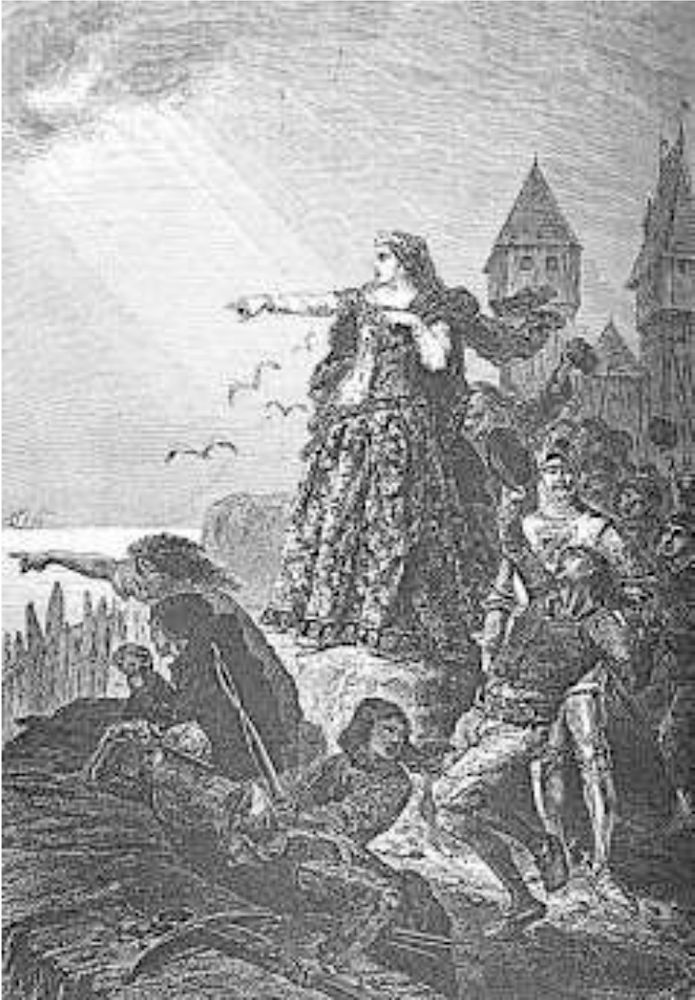

Tickhill Castle as a place of imprisonment
One of the functions served by Tickhill Castle apart from its military and administrative uses was to provide a secure place to detain law-breakers and others. In 1166 when there were very few purpose-built gaols, the Assize of Clarendon decreed that gaols should be made in 'a borough or some castle' at the King's expense, where there were no other gaols, enabling sheriffs to hold securely those who had been arrested. Tickhill and York Castles had gaols in 1166, two of the first in Yorkshire. Other gaols were at Knaresborough (from 1218)and Middleham (from 1237). The gaol could have been a room in the castle walls or gatehouse or a wooden structure in the bailey. However, Tickhill Castle did not only hold local law-breakers.
 In 1202 Queen Eleanor of Aquitaine (left) was besieged in theFrench castle at Mirabeau by forces hostile to her son King John. The castle was captured except for one tower where the Queen took refuge with a few loyal soldiers. A rapid response by King John retook the castle and some 200 knights were captured. They were transferred to various gaols in Normandy and England 'loaded with irons' (collars, ankle rings and chains). One knight was brought to Tickhill Castle gaol. The treatment of these knights is likely to have been severe. For example, of the 25 held at Corfe Castle 22 are believed to have starved to death.
In 1202 Queen Eleanor of Aquitaine (left) was besieged in theFrench castle at Mirabeau by forces hostile to her son King John. The castle was captured except for one tower where the Queen took refuge with a few loyal soldiers. A rapid response by King John retook the castle and some 200 knights were captured. They were transferred to various gaols in Normandy and England 'loaded with irons' (collars, ankle rings and chains). One knight was brought to Tickhill Castle gaol. The treatment of these knights is likely to have been severe. For example, of the 25 held at Corfe Castle 22 are believed to have starved to death.
A more unusual case of confinement began in 1346 when Joan of Flanders was held in Tickhill Castle on the orders of Edward III in what has been described as possible 'benevolent custody on the grounds of ill health'. Whether this was insanity or some other chronic illness is not known. Joan's confinement might also have been politically convenient for Edward III as his support for her family's ambitions in Brittany wavered.

Joan, sister of Louis I Count of Flanders, was married to John, Earl of Richmond and Count of Montfort, whose claim to the dukedom of Brittany in 1341 was contested by Charles of Blois, beginning the Breton War of Succession. John appealed to Philip VI of France for support but wasimprisoned by Philip leaving Joan to fight for her infant son's right of succession. In 1342 Joan led the defence of Hennebont near Brittany's south coast when it was besieged by Charles of Blois, even dressing in armour to lead an attack on Charles' campand burn it. Her appeal to Edward III for help saw English ships sail to the relief of Hennebont. Joan is depicted, right, looking out from Hennebont's battlements in an 1869 History of Franceby François Guizot.
Edward III took the opportunity of John's imprisonment in France to take over the earldom of Richmond and give it to his young son John of Gaunt. Count John was released in 1343 and hostilities ceased; he died two years later by which time Joan had retreated to England with her six year old sonand four year old daughter. They were brought to Tickhill Castle, although the children were subsequently taken into the King's household. As well as Edward III's changed priorities over Brittany, he possibly had no intention of allowing Joan to claim anydower income from the earldom of Richmond.
In November 1347 Warmer de Giston and his men entered Tickhill Castle by force and took Joan to Pontefract, one of the very few examples of women being removed from custody. The whole party was retaken then brought by a royal sergeant-at-arms before the King and his Council. Joan went back into royal custody remaining in 'northern confinement' until her death in 1374.
As a noblewoman Joan was kept in more comfortable circumstances than was the case for some other women held in castles or convents. One annual amount spent on Joan and her family was £173/6/8 as recorded in the account of Thomas de Haukeston, Constable of Tickhill Castle 1346-49. This could have covered food, clothing and medical assistance, for example. She would also have been allowed exercise in the fresh air within the Castle's walls. Subject to the King's orders where a sense of propriety ensured noblewomen were not treated violently or shamed, Joan was nevertheless deprived of freedom for a very long period. Joan's son eventually in 1365 became Duke of Brittany and from 1372, when John of Gaunt took ownership of Tickhill Castle, was able to reclaim the earldom of Richmond and control of the castle there. In 1375 he was installed as a Knight ofthe Garter.
Seabourne, Gwen, Imprisoning medieval women: The non-judicial confinement and abduction of women in England c.1170-1509, Ashgate, 2011Rickard, John, The Castle Community: English and Welsh Castle Personnel 1272-1422,
The Boydell Press, 2002